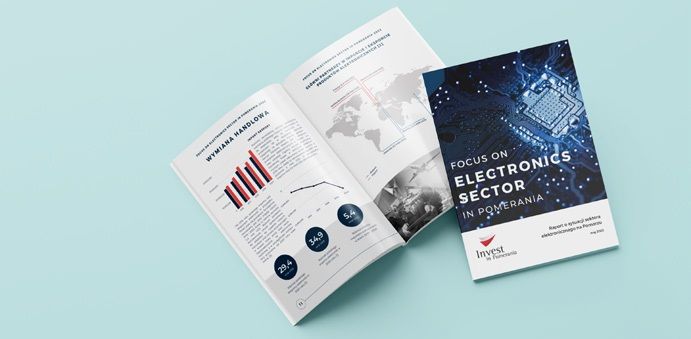Electronics as a driving force of Pomeranian industry

What challenges does automation of production and supply chain organization bring? What does the Pomeranian education and labor market look like? Is the crisis in the semiconductors market an opportunity for the rapidly developing region?
Pomerania is ranked among the most prosperous regions in Europe. On the map of Poland, the most dynamic economy in Central and Eastern Europe (CAEE), it is one of the most attractive areas for locating business. More than 300,000 companies have located their headquarters here, including those from the electronics industry.
– Well-trained and educated staff, investment projects of the biggest players, such as: Flex, Lacroix Electronics, Aptiv, Intel, Northvolt, Radmor – all this generates an investment climate for the electronics industry in Pomerania – says Maciej Marchewka, PR & Marketing Project Manager, Invest in Pomerania.
SPECIFICS OF ELECTRONICS PRODUCTION IN POLAND AND POMERANIA
In terms of trade, the volume of Polish imports of electronic products still slightly exceeds exports. In 2020 this difference has further widened, due to increased sales of consumer electronics resulting from pandemic demand. In turn, the products that Poland successfully exports remain primarily consumer electronics, household appliances and telecommunications, as well as electrical wires. It should be noted that the fastest growing group of goods in the context of exports are batteries and separators, also classified in the SWAiD as electronic equipment.
In Pomerania electronics manufacturing has for years remained one of the key industries both in terms of employment and export activity. At the same time, the sector is characterized by its distinct specificity compared to the rest of the country. While over the past decades the production of consumer appliances (especially consumer electronics and white goods) has developed primarily, Pomerania has developed fabrication models targeted and integrated with various industries, including artificial intelligence, telecommunications and automotive. For the automotive sector, the region produces cameras for autonomous driving, roof panels, electric cars’ chargers, lighting systems, amplifiers, firmware; for other sectors: telecommunications devices, control systems, identity documents, data center infrastructure. At the same time, companies have a very flexible approach to the products they offer – depending on the market demand, they adapt their production to specific industries, as well as constantly expanding the range of services, becoming more and more involved in R&D activities or new product development processes.
Due to climate change, it has become an absolute priority for many electronics companies to achieve climate neutrality within the next few years. PPAs (longterm power supply agreements) are being signed on an increasingly large scale, and new investments are being made in green energy plants for use in industrial processes. Major players, such as Flex and Aptiv, are taking power generation on their own shoulders in order to become less dependent on suppliers and – above all – to lower their company's emissions, meet customer demands and implement a global low-carbon energy policy.
HUMAN RESOURCES – THE BASIS OF THE DEVELOPMENT OF THE ELECTRONICS INDUSTRY
To carry out ambitious investment projects, qualified staff is needed. In Pomerania 14,500 people work in electronics sector and 12,000 of them produce computer, electronic and optical solutions.
This is the best result in the whole country and constitutes as much as 1/5 of all people employed in this industry in Poland.
Naturally, the key role in the supply of talent to the market is played by the educational system. The university that meets the needs of the sector to the greatest extent is the Gdansk University of Technology. It offers as many as 13 faculties, where about 5,400 students educate in the specialties desired by the electronics industry. Companies, in turn, in order to further increase the possibility of acquiring staff, are willing to engage in educational projects, such as joint work on curriculum development, student internships, competitions for best students.
One of the interesting industry initiatives is co-creation of postgraduate studies at the Gdansk University of Technology, titled: Electronic devices manufacturing engineering and Electronics production engineering. On the other hand, one of the interesting industry initiatives is co-creation of courses at postgraduate studies at the Gdansk University of Technology, titled Production Engineering of Electronic Devices and Quality Assurance in the Technical Industry. It is a joint initiative of University, ICT Interizon Cluster and local companies.
Similar activities are undertaken in vocational schools that educate 10,000 students in key occupations for the industry. Half of them are IT technicians. Companies such as Flex and Lacroix are involved in cooperation with vocational schools in the local area. They create, among other things, patronage classes whose graduates are prepared to take up their first job or internship in the industry. Cooperation with schools focuses on investing in the technical and didactic base of schools, transferring knowledge and skills to students and professional development of teachers. Companies also have the opportunity to co-create the offer of vocational education: to give opinions and develop curricula for the profession.
SEMICONDUCTORS – AN OPPORTUNITY FOR POMERANIA?
demand for chips, from the telecommunications and computer sectors, resulted in a noticeable bump. This was further exacerbated by the sudden rebound of the automotive sector in 2021, compounding the demand for microprocessors. The largest silicon wafer manufacturers are in Asia, with 3 countries in the region being de facto monopolies in the field: 63% of factories are owned by Taiwan, 18% by Korea, and 6% by China. The largest manufacturer currently is TSMC (Taiwan Semiconductor Manufacturing Company), which accounts for 54% of the revenue of all semiconductor wafer foundries in the world. There has therefore been a demand for production closer to target markets, such as Europe. In the context of further announced investments in the electronics industry, a fundamental question arises, whether Pomerania can be a potential location of a semiconductor factory? Undoubtedly, the key factor is the availability of suitable investment land. Semiconductor factories, together with the accompanying infrastructure, occupy an area of even several hundred hectares, generate huge demand for electricity, gas, water, must be well connected and at the same time located away from potential sources of vibration (e.g. railroad).
On the other hand, there is an issue of availability of appropriate personnel. For example, Intel's production campus in Leixlip, Ireland, after the completion of the expansion will employ over 6,000 people, including engineers of electronics, automation and chemistry. Therefore, despite the high degree of automation in production, the access to adequate human resources is very important, and the Tricity agglomeration can deliver easily. It is also worth noting that in its analysis for Invest in Pomerania, the World Bank points to manufacturing related to semiconductors as one of the industries that Pomerania has a chance to develop in the future. Taking into account good infrastructure and well-trained staff, there is a unique opportunity to create a semiconductor manufacturing hub in CAEE.
Authors: Radosław Młynarczyk, PR & Marketing Associate; Tomasz Wrzask, PR & Marketing Project Manager,
Invest in Pomerania
This article comes from magazine:
FOCUS ON Business #5 July-August (4/2022)
 Check the issue
Check the issue








